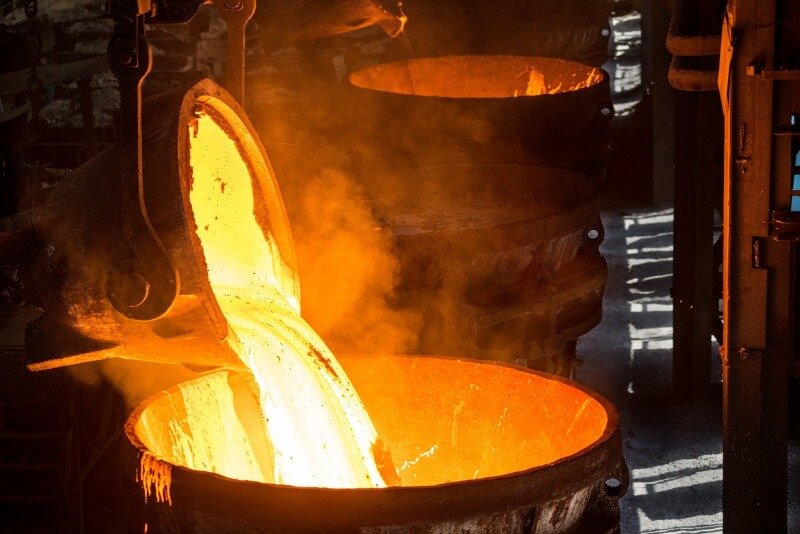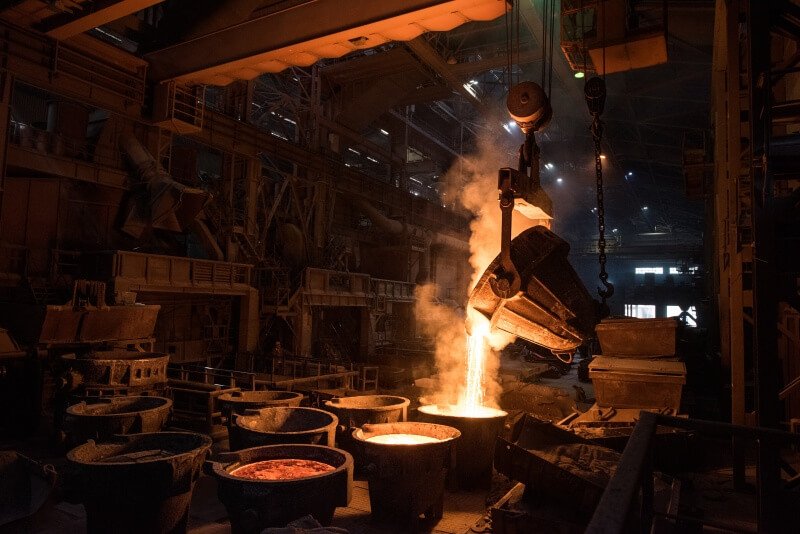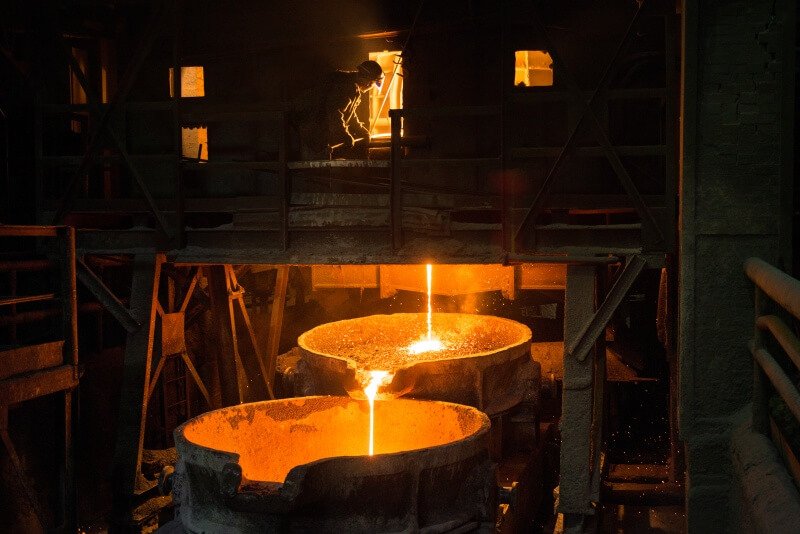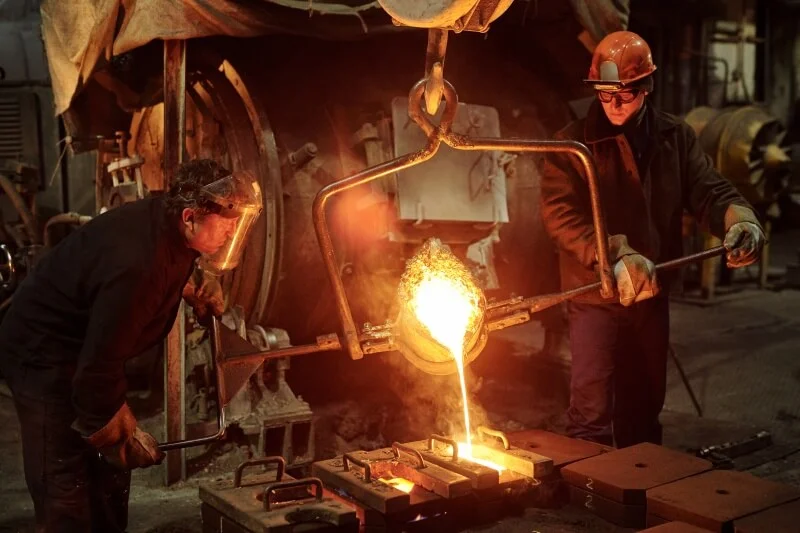Struggling to identify a material that delivers the right mix of strength, geometry, and cost for mission-critical parts is a familiar challenge. Poor decisions often result in project delays, budget overruns, or premature failures that compromise reliability. The versatility of alloy steel casting addresses these challenges head-on by offering customizable properties, proven durability, and cost-effectiveness. This guide explores its production, mechanical characteristics, and composition, giving you the insights needed to make informed choices for your next project.
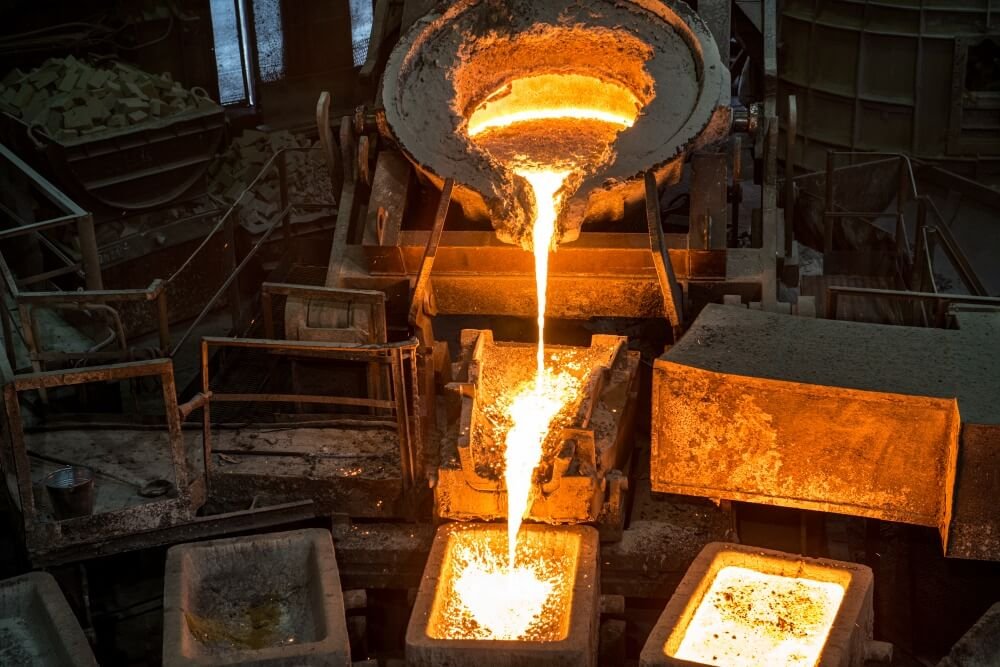
Properties of alloy steel casting
The mechanical properties of your casting determine its real-world performance. By understanding these traits, you can select a material that perfectly matches your application’s demands for durability and resilience.
How are hardness and strength different?
Hardness measures a material’s resistance to surface wear, while strength defines its ability to resist deformation under force. Think about it: a high-carbon steel might be very hard for cutting tools, but you need high strength for structural beams.
- Hardness: Resists scratching and abrasion.
- Strength: Withstands applied loads without breaking.
Ductility and toughness in applications
Ductility is the ability to deform without fracturing, while toughness is the capacity to absorb energy before failing. Here’s the bottom line: ductile materials are needed for components that must bend, whereas tough materials are crucial for parts that absorb impacts.
- Ductility: Essential for flexible parts.
- Toughness: Critical for impact-resistant components.
Achieving wear & corrosion resistance
You can dramatically improve performance by adding specific elements to your alloy steel casting. But what does that mean? Elements like chromium create a protective surface layer, which is vital for parts exposed to harsh environmental or chemical conditions.
- Wear Resistance: Add chromium and molybdenum.
- Corrosion Resistance: Add chromium and nickel for stainless steel properties.
Key Takeaway: This allows you to engineer components that last longer in demanding environments, reducing replacement costs and downtime.
| Property | Description | Key Influencers |
|---|---|---|
| Hardness | Resistance to surface wear and abrasion. | Carbon content, heat treatment |
| Strength | Ability to resist deformation under load. | Carbon content, alloying elements |
| Ductility | Ability to stretch or deform without breaking. | Lower carbon content |
| Toughness | Ability to absorb energy and resist fracture. | Alloying elements, heat treatment |
This table shows how different properties are influenced by composition and processing, enabling precise material customization.
Key factors in alloy steel casting
Beyond basic properties, you must consider how the alloy steel casting will be integrated into your production workflow. Machinability and weldability are two critical factors that directly impact your project’s cost and timeline.
Why is machinability important?
Machinability refers to how easily you can cut, drill, or shape a material. Here’s the deal: better machinability means faster production times, lower tooling costs, and a superior surface finish on the final part.
- Good Machinability: Reduces production costs.
- Poor Machinability: Increases tool wear and time.
Weldability for complex assembly
Weldability is essential when you need to join multiple cast components into a larger, more complex assembly. But what does this actually mean? A highly weldable alloy steel casting ensures strong, reliable joints without introducing structural weaknesses.
- High Weldability: Allows for robust fabrication.
- Low Weldability: Risks cracking or brittle joints.
How are key properties balanced?
You can’t maximize every property at once; it’s a balancing act controlled by composition and heat treatment. Think about it: increasing hardness through high carbon content often reduces the material’s weldability and ductility.
- Balance: Tailor the alloy for specific needs.
- Trade-offs: Acknowledge that one property may affect another.
Key Takeaway: Understanding these factors lets you optimize your alloy steel casting for both final performance and manufacturing efficiency.
| Factor | Importance in Production | Desired Outcome |
|---|---|---|
| Machinability | Affects cost and speed of finishing processes. | Reduced tooling wear, faster cycle times |
| Weldability | Critical for fabricating complex assemblies. | Strong, defect-free joints |
This comparison highlights the manufacturing considerations that are just as crucial as the material’s end-use properties.
Carbon’s role in alloy steel casting
Carbon is the single most important element influencing the properties of your alloy steel casting. The percentage of carbon dictates the material’s hardness, strength, and ductility, making it a primary tool for customization.
Low carbon steel uses and limits
With a carbon content below 0.2%, this steel is soft and highly ductile, making it easy to form. You might be wondering about its limits: it doesn’t respond well to heat treatment, so you can’t significantly increase its hardness.
- Uses: General structural parts, simple fixtures.
- Limits: Low strength and wear resistance.
Medium carbon steel’s versatility
Containing 0.2% to 0.5% carbon, this type offers a balanced profile of strength, ductility, and hardness. Here’s the bottom line: it’s a versatile workhorse suitable for a wide range of applications that require moderate durability.
- Properties: Good balance of strength and toughness.
- Applications: Gears, axles, and structural components.
High carbon steel for peak hardness
With over 0.5% carbon, this steel is your choice for maximum hardness and wear resistance. But what does that mean? It’s ideal for components that must endure extreme abrasion, like cutting tools or heavy machinery parts.
- Strength: Excellent hardness and wear resistance.
- Weakness: More brittle and less ductile.
Key Takeaway: By selecting the right carbon level, you can precisely match the material’s fundamental properties to your application’s needs.
| Carbon Steel Type | Carbon Content | Key Characteristics |
|---|---|---|
| Low Carbon | ≤ 0.2% | Soft, ductile, poor response to heat treatment |
| Medium Carbon | 0.2%–0.5% | Balanced strength, ductility, and hardness |
| High Carbon | > 0.5% | Very hard, high wear resistance, brittle |
This table clarifies how a small change in carbon content can create materials for entirely different purposes.
Elements of alloy steel casting
While carbon sets the baseline, adding other elements to create an alloy steel casting unlocks specialized properties. These additions can dramatically improve everything from corrosion resistance to high-temperature strength.
What defines low-alloy steels?
Low-alloy steels contain up to 8% alloying elements, giving them higher hardenability and strength than carbon steels. Here’s the deal: they offer an excellent performance boost without the cost of high-alloy alternatives.
- Benefit: Enhanced strength and toughness.
- Composition: Contains small amounts of Ni, Cr, Mo.
High-alloy specialty steels
Containing more than 8% alloying elements, these are engineered for extreme conditions. Think about it: this category includes materials designed to resist intense heat, chemical corrosion, or extreme abrasive forces.
- Purpose: Designed for specific, harsh environments.
- Examples: Tool steels, stainless steels.
Stainless & Hadfield’s manganese steel
These are prime examples of high-alloy steels. But what does this actually mean? Stainless steel uses chromium for corrosion resistance, while Hadfield’s steel uses manganese for incredible toughness and work-hardening properties.
- Stainless Steel: >10.5% chromium for rust prevention.
- Hadfield’s Steel: High manganese for impact resistance.
Key Takeaway: Alloying lets you create a custom material with highly specific performance traits for the most demanding jobs.
| Alloy Type | Alloying Content | Primary Advantage |
|---|---|---|
| Low-Alloy Steel | ≤ 8% | Improved hardenability and strength |
| High-Alloy Steel | > 8% | Specialized properties (e.g., corrosion resistance) |
This table differentiates between low and high-alloy steels, showing the trade-off between performance and complexity.
Steel grades for alloy steel casting
Steel grades are standardized classifications that ensure your alloy steel casting meets specific chemical and physical properties. These standards, set by organizations like ASTM, provide a reliable framework for quality control.
How are steel grades classified?
Grades classify steels based on their chemical composition and resulting mechanical properties like tensile strength and hardness. You might be wondering why this matters: it guarantees that a part made today will be identical to one made next year.
- Classification: Based on composition and performance.
- Organizations: ASTM, SAE, AISI.
Cast vs. wrought steel compositions
Though often classified similarly, cast steels typically have higher silicon and manganese content than their wrought counterparts. Here’s the bottom line: this difference helps improve the flow of molten metal into the mold and de-oxidizes the steel.
- Cast Steel: Higher Si and Mn for better castability.
- Wrought Steel: Formed by mechanical working.
De-oxidation in the casting process
Elements like aluminum are added during the melting process to remove oxygen, a common impurity. But what does that mean? This step is critical for preventing gas porosity, an internal defect that can create weak spots in the final casting.
- De-oxidizers: Aluminum, titanium, and zirconium.
- Purpose: To remove dissolved oxygen and prevent defects.
Key Takeaway: Relying on standardized grades ensures your components meet precise specifications for reliable and repeatable performance.
| Steel Type | Key Difference | Primary Reason |
|---|---|---|
| Cast Steel | Higher silicon and manganese content. | Improves fluidity and de-oxidizes the melt. |
| Wrought Steel | Lower silicon and manganese content. | Optimized for mechanical forming processes. |
This analysis shows the subtle but critical compositional differences between cast and wrought steels.
EAF process for alloy steel casting
The Electric Arc Furnace (EAF) is a cornerstone of modern steel production, offering precise control over the melting process. It is ideal for producing high-quality alloy steel casting from scrap materials.
How does an Electric Arc Furnace work?
An EAF uses high-energy graphite electrodes to create an arc, generating intense heat to melt steel scrap and alloys. Think about it: this direct application of thermal energy allows for rapid melting and precise temperature management.
- Energy Source: Electrical arc from graphite electrodes.
- Feedstock: Primarily recycled steel scrap.
The tap-to-tap EAF operational cycle
The process runs in a continuous loop: charging the furnace, melting the scrap, refining the molten steel, and tapping it into a ladle. Here’s the deal: this efficient cycle allows for the consistent production of steel heats.
- Steps: Charging, melting, refining, de-slagging, tapping.
- Outcome: A batch of molten steel ready for casting.
Refining and de-slagging explained
During refining, oxygen is injected to remove impurities, which rise to the surface to form a layer of slag. But what does this actually mean? De-slagging, or removing this layer, is crucial for producing clean, high-quality steel.
- Refining: Purifies the steel with oxygen.
- De-slagging: Removes the slag and its impurities.
Key Takeaway: The EAF process gives you precise chemical control, ensuring your alloy steel casting meets exact specifications.
| EAF Cycle Stage | Action | Purpose |
|---|---|---|
| Charging | Load scrap steel into the furnace. | Prepare the raw materials for melting. |
| Melting | Apply electrical and chemical energy. | Liquefy the steel scrap and alloys. |
| Refining | Inject oxygen into the molten bath. | Remove carbon and other impurities. |
| Tapping | Pour molten steel into a ladle. | Transfer the steel for casting. |
This cycle breakdown illustrates the systematic process used to transform scrap into high-grade liquid steel.
Furnaces for alloy steel casting
While the EAF is a popular choice, the induction furnace offers another powerful method for producing alloy steel casting. Both furnaces play a key role in recycling steel, a practice that is both economical and environmentally friendly.
Induction furnace advantages
An induction furnace uses electromagnetic currents to heat and melt metal with minimal material loss. You might be wondering about its key advantage: it’s incredibly efficient and clean, perfect for producing specific alloys without contamination.
- Mechanism: Electromagnetic induction.
- Benefits: High efficiency, low melt loss.
Why use recycled steel scrap?
Using recycled steel from sources like old cars and machinery dramatically reduces cost and environmental impact. Here’s the bottom line: it conserves natural resources and lowers the energy required compared to producing steel from raw iron ore.
- Sources: Obsolete components, internal foundry scrap.
- Impact: Reduces costs and promotes sustainability.
Key Takeaway: Choosing the right furnace technology and leveraging recycled materials allows you to produce high-quality castings sustainably and cost-effectively.
| Furnace Type | Heating Method | Key Advantage |
|---|---|---|
| Electric Arc Furnace (EAF) | Electrical arc | Excellent refining capability |
| Induction Furnace | Electromagnetic induction | High efficiency and minimal material loss |
This comparison clarifies the distinct advantages of the two primary furnace types used in modern foundries.
How to heat treat alloy steel casting
After casting, you’re not done—heat treatment is a critical final step to refine the material’s properties. These controlled heating and cooling cycles allow you to fine-tune the balance of hardness, strength, and ductility.
Annealing to improve ductility
Annealing involves heating the casting and cooling it very slowly to soften the metal and relieve internal stresses. Here’s the deal: this process increases ductility, making the part less brittle and easier to machine.
- Process: Heat and slow cool.
- Result: Softer, more ductile, and stress-free material.
Normalizing for strength and hardness
Similar to annealing, normalizing also involves heating the casting but uses air cooling for a faster cool-down. Think about it: this faster rate refines the grain structure, resulting in a stronger and harder steel.
- Process: Heat and air cool.
- Result: Increased strength and hardness.
Quenching and tempering methods
This two-step process involves rapid cooling (quenching) in water or oil to achieve maximum hardness, followed by reheating (tempering) to reduce brittleness. But what does this actually mean? It allows you to achieve an optimal balance of hardness and toughness.
- Quenching: Rapid cool for extreme hardness.
- Tempering: Reheat to restore some toughness.
Key Takeaway: Heat treatment gives you ultimate control to transform a raw casting into a high-performance component.
| Heat Treatment | Cooling Method | Primary Outcome |
|---|---|---|
| Annealing | Slow furnace cooling | Maximum softness and ductility |
| Normalizing | Air cooling | Increased strength and hardness |
| Quenching | Rapid liquid cooling | Maximum hardness |
This summary shows how different cooling rates produce dramatically different mechanical properties in the final product.
Inspecting your alloy steel casting
Rigorous inspection is non-negotiable to ensure every alloy steel casting meets your quality and reliability standards. This process verifies everything from dimensional accuracy to internal soundness before a part is cleared for use.
Confirming dimensional accuracy
Your castings must conform precisely to design tolerances. Here’s the bottom line: inspectors use calipers and gauges to check external dimensions, while some parts may require destructive testing to verify internal features.
- Goal: Ensure the part matches the design drawing.
- Methods: Measurement tools, destructive sectioning.
What is surface finish inspection?
This step looks for visual and sub-surface flaws that could compromise performance or aesthetics. You might be wondering what causes these: the mold type, sand quality, and cleaning methods all influence the final surface finish.
- Defects: Cracks, pits, or other irregularities.
- Influences: Pattern, mold materials, and cleaning.
Common internal soundness defects
Porosity, inclusions, and shrinkage are three common internal defects that can lead to failure. But what does that mean? These hidden flaws create weak spots, so foundries use soundness specifications to define acceptable defect levels.
- Porosity: Gas bubbles trapped during solidification.
- Inclusions: Foreign materials like sand in the casting.
- Shrinkage: Voids caused by insufficient liquid metal.
Key Takeaway: A thorough inspection process guarantees that your components are free from critical defects and fit for their intended purpose.
| Internal Defect | Description | Cause |
|---|---|---|
| Porosity | Smooth-walled internal voids. | Gas trapped during casting. |
| Inclusions | Trapped foreign material (e.g., sand). | Debris entering the mold. |
| Shrinkage | Rough, crystalline cavities. | Insufficient feed metal during solidification. |
This table identifies the most common hidden dangers in castings and their root causes.
Testing your alloy steel casting
To guarantee performance, your alloy steel casting must undergo chemical and mechanical testing. These tests verify that the material’s composition and its ability to withstand stress align with the design specifications.
Heat and product analysis explained
Heat analysis checks the chemical composition of the molten steel before casting, while product analysis verifies the composition of an individual finished part. Here’s the deal: this two-stage verification ensures chemical consistency from start to finish.
- Heat Analysis: Checks the molten metal batch.
- Product Analysis: Confirms the final casting’s chemistry.
What is non-destructive testing?
Non-destructive testing (NDT) allows you to verify the internal and external soundness of a casting without damaging it. Think about it: methods like X-ray or ultrasonic testing find hidden flaws so the part can still be used if it passes.
- Methods: Radiography (X-ray), ultrasonic, magnetic particle.
- Advantage: Verifies quality without destroying the part.
Verifying tensile properties
Tensile testing measures a casting’s ability to withstand pulling forces. But what does this actually mean? A sample bar is pulled until it breaks, providing critical data on its ultimate strength and ductility.
- Process: A sample is pulled apart until failure.
- Data: Measures tensile strength, yield strength, and elongation.
Key Takeaway: Rigorous testing is the final step that proves your component has the specific mechanical properties required to perform reliably under load.
| Testing Type | Description | When It’s Used |
|---|---|---|
| Destructive Testing | The test piece is destroyed to gather data. | To verify internal properties of a sample. |
| Non-Destructive Testing (NDT) | The part is inspected without being damaged. | To confirm the soundness of every shippable part. |
This analysis contrasts the two fundamental approaches to quality verification in the foundry.
Conclusion
By understanding the properties, composition, and production of alloy steel casting, you can specify durable and cost-effective components that overcome the limits of generic materials. For custom alloy steel casting solutions tailored to your project’s unique demands, contact the experts at Precisionvast today for a consultation. Our mission is to deliver superior casting solutions by combining metallurgical science with hands-on expertise, ensuring our partners receive components that set new standards for performance and reliability.
Frequently Asked Questions (FAQ)
1. Q: What’s the best type of steel for high-wear parts? A: High-carbon or high-alloy steels are best. These materials, such as Hadfield’s manganese steel, are specifically designed with elements that provide maximum hardness and abrasion resistance.
2. Q: Can I weld components made from alloy steel casting? A: Yes, but with care. Weldability depends on the carbon and alloy content; low-carbon steels are easily welded, while high-carbon and certain alloy steels may require special pre-heating and post-welding procedures to prevent cracking.
3. Q: How does heat treatment actually change steel? A: It modifies the steel’s internal crystal structure (microstructure). Processes like quenching create a very hard but brittle structure, while tempering or annealing refines that structure to achieve a desired balance of hardness and toughness.
4. Q: Is recycled steel as good as new steel for casting? A: Yes, absolutely. Modern furnace technology like the EAF allows foundries to refine recycled scrap and precisely control the final chemical composition, producing steel that is metallurgically identical to steel made from raw materials.
5. Q: How do I choose between carbon and alloy steel? A: It depends on your application’s demands. Use carbon steel for general-purpose applications where cost is a major factor, and choose an alloy steel casting when you need superior properties like high strength, corrosion resistance, or performance at extreme temperatures.

